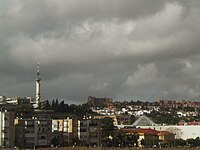El Aljarafe
| El Aljarafe | |
|---|---|

|
|
| Location of the Comarca Aljarafe in Andalusia | |
| Basic data | |
| Province: | Seville |
| Main place: | |
| Surface: | 1136 km² |
| Residents: | 89,138 (2019) |
| Municipalities: | 13 |
The Comarca Aljarafe is one of the nine comarcas in the province of Seville . Like all comarcas in the autonomous community of Andalusia , it was established with effect from March 28, 2003.
The comarca in the west of the province comprises 13 municipalities with an area of 1136 km².
location
| Sierra Norte | ||
| Huelva Province |

|
Comarca Metropolitana de Sevilla |
| Costa Noroeste de Cádiz |
Communities
| local community | Population as of January 1, 2019 |
|---|---|
| Albaida del Aljarafe | 3197 |
| Aznalcázar | 4586 |
| Benacazón | 7241 |
| Bollullos de la Mitación | 10,787 |
| Carrión de los Céspedes | 2544 |
| Castilleja del Campo | 629 |
| Huévar del Aljarafe | 3015 |
| Olivares | 9394 |
| Pilas | 13,974 |
| Sanlúcar la Mayor | 13,808 |
| Umbrete | 8894 |
| Villamanrique de la Condesa | 4459 |
| Villanueva del Ariscal | 6610 |
etymology
The name corresponds to a term in the Arabic language that means "hill" or "elevation" ( Arabic شَرَفٌ, DMG aš-šaraf un ).
geography
El Aljarafe includes some rolling hills. Its height above sea level does not exceed 200 m. The rivers that cross it, such as the Majalbarraque, the Pudio, the Montijos, the Ardachón and the Valdegallinas, occasionally get high water levels up to floods due to rainy seasons or downpours. However, they usually dry out in summer. The sometimes rugged topographical shapes are due to this change.
history
The Tartessian culture is considered to be the oldest to have settled Aljarafe. Here the famous treasure of El Carambolo was found.
The Roman conquerors named the area Vergetum and exported wine and oil from here to Rome and other cities of the Roman Empire. From this period the Roman bridge of Aznalcázar and some mosaics in Castilleja del Campo have been preserved.
A great development took place during the Muslim era , as testified by the towers of Olivares and Albaida del Aljarafe , as well as various mosques that were later converted into Christian churches.
El Aljarafe was a comarca of great agricultural wealth, due to its location between the Guadalquivir and Guadiamar rivers and the two streams that flow through Villanueva del Ariscal .
today

In less than 20 years Aljarafe became a suburb of more than 300,000 inhabitants in the largest metropolitan area in southern Spain, Seville.
The growth begins in the 1940s when the upper class of the Andalusian capital began to look for their residences outside the big city. The rapid growth brought with it some difficulties, such as the lack of schools and medical care, as well as traffic problems due to the large number of commuters.
For El Aljarafe, a population of half a million is forecast within a metropolitan area with almost two million inhabitants within the next decade.
So far, El Aljarafe has some facilities of its own, including hospitals, a private university, television studios, hotels and shopping centers, among the latter one of the largest in southern Spain. However, the connections to Seville are congested for long periods of time every day. Line 1 of the Seville Metro , which has already been completed, is intended to relieve this region.
Classification
El Aljarafe is organized in three rings:
- The first (eastern) sector consists of Bormujos , Camas , Castilleja de la Cuesta , Castilleja de Guzmán , Gelves , Gines , Mairena del Aljarafe , Palomares del Río , Santiponce , Tomares , San Juan de Aznalfarache and Valencina de la Concepción .
- The second (middle) sector includes Albaida del Aljarafe , Almensilla , Benacazón , Bollullos de la Mitación , Coria del Río , Espartinas , Olivares , La Puebla del Río , Sanlúcar la Mayor , Salteras , Umbrete and Villanueva del Ariscal .
- The third (western) sector includes Aznalcázar , Carrión de los Céspedes , Castilleja del Campo , Huévar del Aljarafe , Pilas and Villamanrique de la Condesa .
El Aljarafe is also divided into corridors: north (between the railway line and the A-49), center (between the A-49 and the expressway to Mairena), center-south (south of the expressway to Mairena) and on the bank (on the Expressway to Coria).
language
There are over 500 specific expressions for the western El Aljarafe, including: abanador , (a) barrumbado , aboparse , achichotarse , de aguas allá , ajolá , algofifa , amorrarse , ancá , anteoso , antiernoche , apulgararse etc.
Individual evidence
- ↑ Orden de 14 de March 2003, por la que se aprueba el mapa de comarcas de Andalucía a efectos de la planificación de la oferta turística y deportiva, Boletín Oficial de la Junta de Andalucía (Official Gazette of the Government of Andalusia), No. 59 of March 27, 2003, p. 6248
- ↑ Cifras oficiales de población resultantes de la revisión del Padrón municipal a 1 de enero . Population statistics from the Instituto Nacional de Estadística (population update).
- ↑ [1] Fernando José Sánchez Bautista: Glosario léxico y fraseológico de uso en la localidad de Pilas y otras zonas del Aljarafe occidental sevillano. In: Sobre Historia de Pilas. Volume 8, Ayuntamiento de Pilas, pp. 123-151


